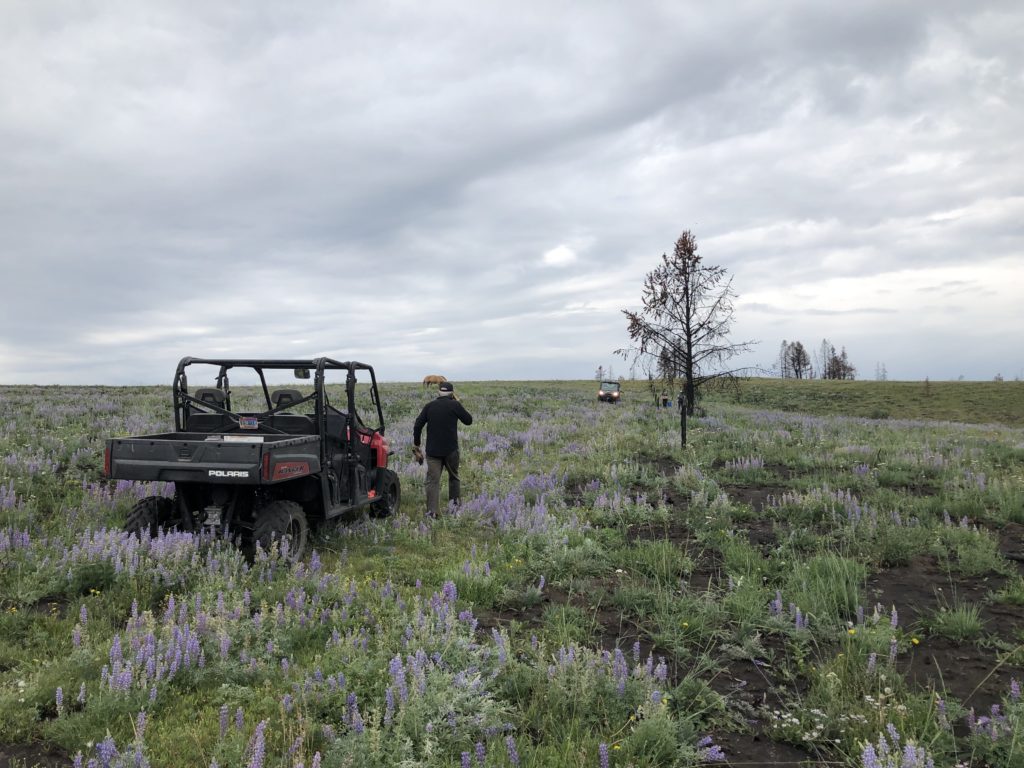By Kyle Kissock, Communications Manager
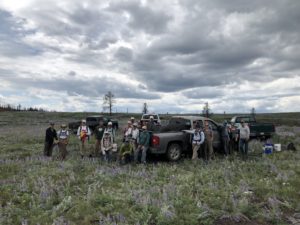
Thirty JHWF volunteers partnered with local property owners and families to help removed burned fence at Hoback Ranches. The community is installing over 10 miles of wildlife-friendlier fence in this critical migration corridor.
Not all wildlife-friendlier fence projects are created equal.
Rarely, for example, are Jackson Hole Wildlife Foundation fence volunteers treated to homemade pastries, a full wash station, and unobstructed mountain views all in one project. And never before have we had the privilege of assisting a local community rebuild its wildlife-friendly infrastructure after a destructive wildfire.
But let’s start at the beginning.
Formed in 1976, the Hoback Ranches subdivision was one of the first of its kind in Wyoming. It’s a community with a history of resiliency; until recently, Rim Road, the artery which connects the Ranches to Highway 89, was unplowed in winter. Year-round residents had to snowmobile or ski the entire distance up the Rim Road from the Highway to reach their homes. Apparently, there was a surprising contingent of these hearty locals who did.
Wildlife conservation has also been a core values of Hoback Ranches since its founding. The Ranches are located in the Hoback to Red Desert migration corridor for mule deer, as well as a prominent pronghorn migration pathway. An elk feed grounds to the south means migrating elk are community regulars. According to long-time resident Bill Conley, the area also provides habitat for abundant badgers, “chiselers,” coyotes, jack rabbits, snow shoe hare, and even more seldom-seen critters like Great Gray Owls, black bears, and the occasional mountain lion or wolf. An abundance of water and willows, large lot sizes, and hunting restrictions all add to the area’s high habitat value.
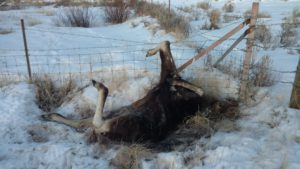
The remains of a moose that became entangled in a Wyoming fence during the winter of 2018/2019. Wildlife-friendly modifications to fence lines can prevent human-cause mortalities like this one.
To make life easier on wildlife, Hoback Ranches recently collaborated with Wyoming Game and Fish on a grant to fund replacement of the 19 miles of barbed-wire fence that ran the length of the subdivision’s perimeter, with wildlife-friendlier fencing. Wildlife-friendlier fencing generally contains a smooth-wire component, and/or abides by dimensions which allow wildlife to travel over or under wires with minimal risk of entanglement. The grant was accepted and funded by the Jonah Interagency Mitigation and Reclamation Office and the Pinedale Anticline Project Office.
However, replacement of the existing barbed-wire had scarcely begun before last October’s human-caused Roosevelt fire swept through the subdivision. The fire obliterated homes and consumed the natural landscape, along with the beginnings of the recently-funded wildlife friendlier fence modifications.
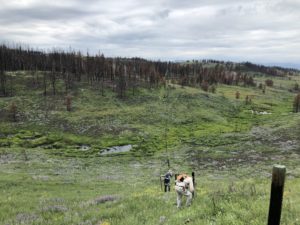
The hilly topographic character of the landscape here made removing wire somewhat challenging but added to the stunning scenery of project site.
For those who haven’t traveled to the Roosevelt Fire burn zone, the full extent of the fire’s impact on the landscape is jaw-dropping. By the time the massive 61,000-acre blaze ran its course, it destroyed 50 houses in Hoback Ranches, nearly half of which belonged to permanent residents. Much the conifer and aspen growth that covered the Ranches’ hills now stands charred, and many of the houses that survived the blaze sit exposed in the vast expanse of blackened timber and sage.
But what also stands out is the regrowth. Less than a year from the fire, green grasses, patches of fireweed, and fields of knee-high purple lupine coat the burnt understory in midsummer. The human regrowth Hoback Ranches is experiencing is also apparent. The drone of power tools, raising new homes and clearing wasted timber and roadways, echo across the Ranches hillsides. Regrowth emergent, resiliency in action.
In July, volunteers from the Jackson Hole Wildlife Foundation were asked to help remove the old perimeter fence that had been destroyed by the fire. Because most of the subdivision is bordered by actively grazed land, fencing here is still necessary, and miles of fence downed by the fire need to be removed before the wildlife-friendlier fencing can installed. Furthermore, even in its dilapidated state, downed wire presents an entanglement hazard for passing wildlife.
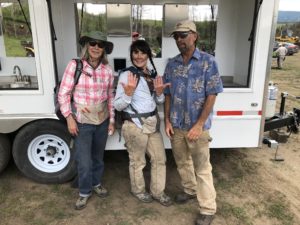
This wash station came in quite handy for cleaning soot off our bodies and clothes. Staying clean was quite impossible.
The first step of the process was separating burned wire from charred fence posts. Volunteers developed a system of removing staples from the posts to free the wire, then spanning into human “disassembly lines” to walk the loose wires towards our wire-winder. Wire ends were tied to the winder, which provides a mechanical advantage in coiling large lengths of fencing into manageable spools. These smaller spools could then easily be removed from the site in the beds of pickup trucks. In areas of steep terrain, where burned trees and brush were too dense to operate the wire-winder, volunteers were forced to roll fencing by hand. It was a dirty, sooty job, but it was rewarding. Generous Hoback Ranches residents provided us with cookies, brownies, and a wash station (the same type that wildland firefighters use) we found to be icing on the cake.
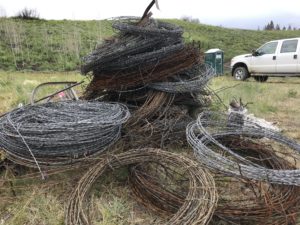
Barbed-wire rolls generated by the winder. By the time we had finished, JHWF volunteers had partnered with residents to remove three miles of wire in two field-days of work.
After two full days of work, JHWF volunteers had partnered with landowners to remove three miles of dilapidated wire. 30 JHWF fence team volunteers had contributed an impressive 298 total volunteer hours to the effort. With a little more labor, Conley and fellow homeowners hope to complete the project by next spring.
Staff and volunteers of the Jackson Hole Wildlife Foundation were honored to be made a part of this community’s rebuild, even in our own small way. We were also grateful to get to experience the scenic beauty of the area which still very much remains intact after the fire.
A sincere thank you to all who were a part of this truly special experience!
If you’d like to get involved with volunteering on our fence team in the future and are not already on our mailing list, email info@jhwildlife.org to sign up!

